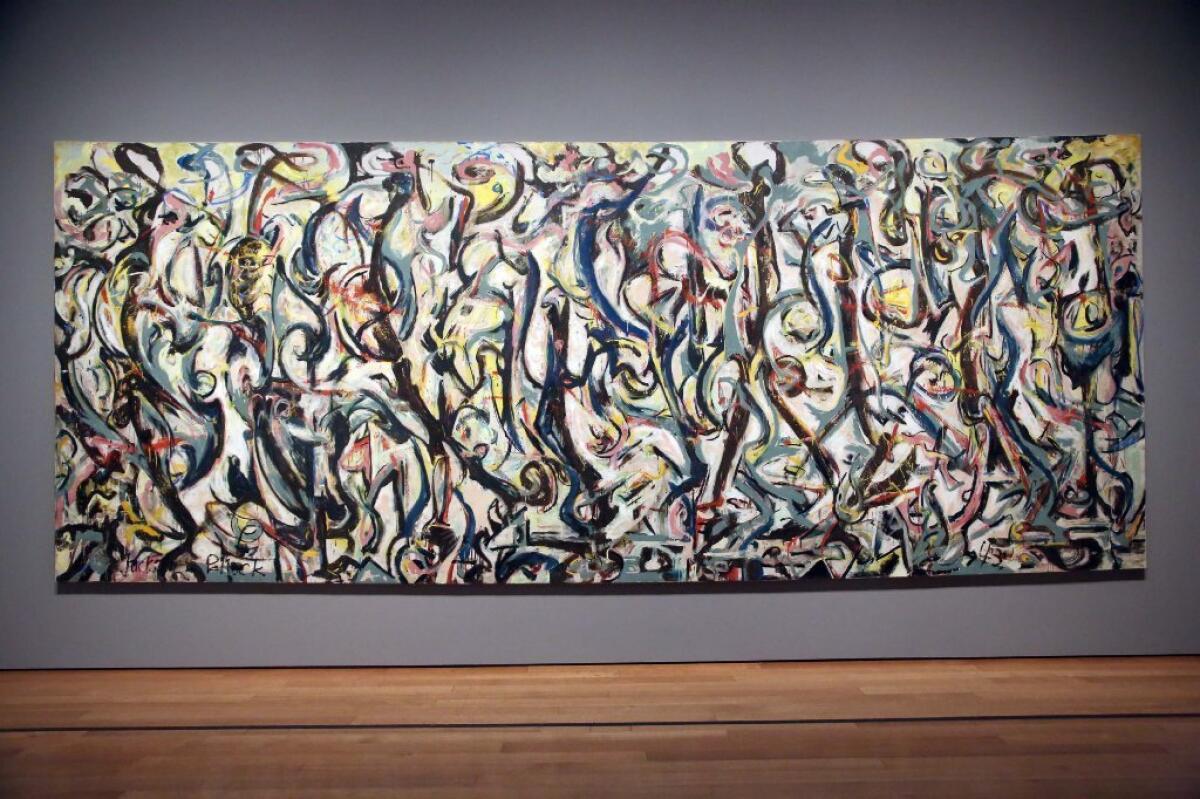Is Jackson Pollock’s name hidden in ‘Mural’?

Four and a half years ago, Smithsonian magazine offered what was then the latest theory on the genesis of “Mural,” the epic Jackson Pollock painting that went on view at the J. Paul Getty Museum on Tuesday following 21 months of detailed conservation work.
Doubts that Pollock painted the 20-foot canvas in one sustained burst of all-night creative fervor, which was central to the artist’s myth promoted by his widow, painter Lee Krasner, had been growing for some time — most cogently in the work of Pollock scholar Francis V. O’Connor. As I wrote on Monday, Getty conservators have now laid that myth to rest, showing through careful scientific and other analysis how it was virtually impossible.
The Smithsonian story was not about the duration of Pollock’s effort in painting “Mural” but about his composition.
WATCH: Getty explains conservation of Pollock’s 1943 ‘Mural’
Contributing editor Henry Adams, a Case Western Reserve University specialist in 19th century American art but an admirer of the Modern painter’s work, had an idea. In an article promoting the imminent publication of his 2009 book, “Tom and Jack: The Intertwined Lives of Thomas Hart Benton and Jackson Pollock,” he suggested that, in effect, the name’s the thing.
In “Decoding Jackson Pollock,” Adams wrote, “I’m now convinced that Pollock wrote his name in large letters on the canvas — indeed, arranged the whole painting around his name.”
He wasn’t referring to the artist’s signature at the lower left, which Pollock added almost four years after he finished “Mural.” Instead, inspired by an observation first made by Adams’ wife, art historian Marianne Berardi, he went on to show where the letters of the artist’s first and last names could be detected — in proper order — beneath the roiling shapes and colors all across the densely painted field.
“It may not be possible to answer the question definitively unless scientists use X-ray scanning or some other method to trace which pigments were put down first,” Adams observed.
Now that Getty conservators have done exactly that (and more), it seemed to be worth checking in on what they found. Does Pollock’s name appear in the under-painting of the canvas, either as a compositional motif or otherwise?
PHOTOS: Best art moments of 2013
The Getty Museum’s Yvonne Szafran said no. So did the Getty Conservation Institute’s Tom Learner.
“We knew about the proposal but found no evidence supporting it,” Szafran said in an email. Added Learner, “None of the scanning techniques employed (X-ray fluorescence and hyper spectral imaging) detected anything resembling his name.”
Another one bites the dust.
To be fair, Adams did write that other art historians with whom he shared his speculation expressed serious doubts. And speculation based on visual evidence is a basic tool for art historians. That it didn’t pan out this time and that O’Connor’s doubts about the one-night painting myth have been definitively confirmed by the scientific evidence from Getty conservators are simply examples of how the history of art slowly but steadily evolves.
ALSO:
Jane and Marc Nathanson to sell three works from collection
Carlos Almaraz’s time is coming, nearly 30 years after death
L.A. Philharmonic’s Minimalist Jukebox festival reveals a wide range
More to Read
The biggest entertainment stories
Get our big stories about Hollywood, film, television, music, arts, culture and more right in your inbox as soon as they publish.
You may occasionally receive promotional content from the Los Angeles Times.







